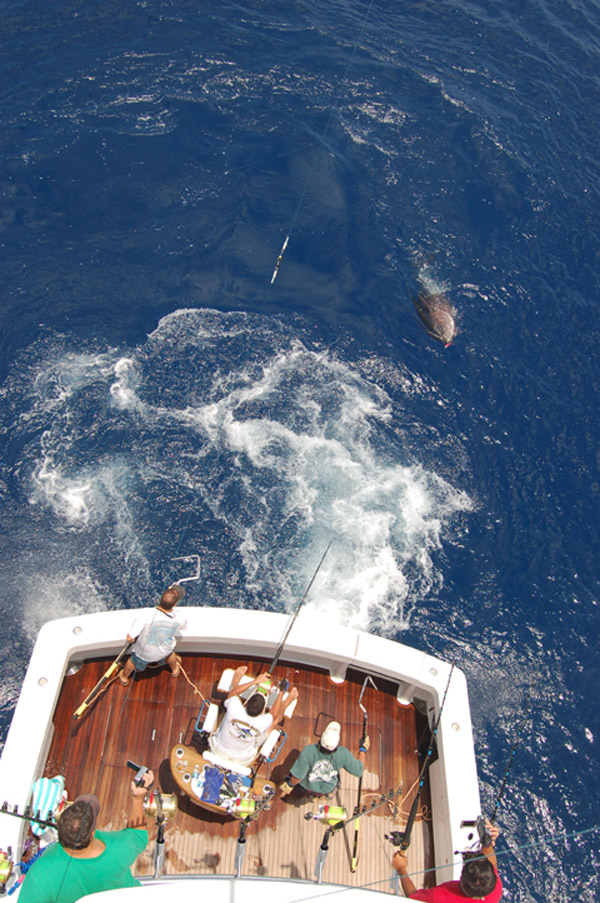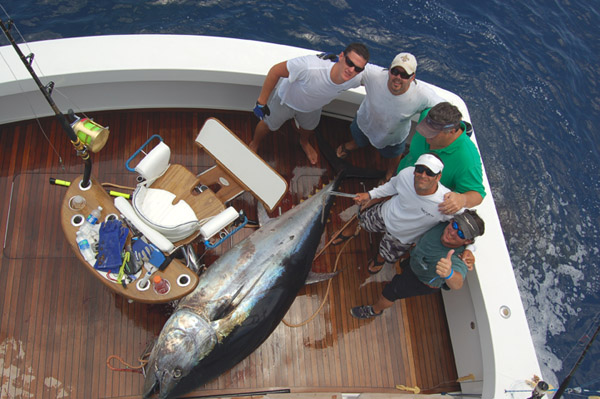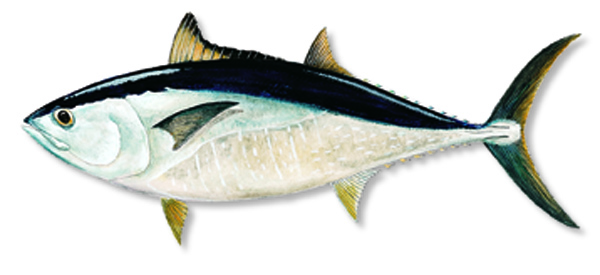March 01, 2010
By Buck Hall
Tripmakers, mojo and the catch of a lifetime.
 On June 6, 2009, Pensacola-based sportfisher battles the surprise bite of the season, a rare giant bluefin, hooked while marlin fishing in the Gulf.
On June 6, 2009, Pensacola-based sportfisher battles the surprise bite of the season, a rare giant bluefin, hooked while marlin fishing in the Gulf.
On that trip our fishing started about 240 miles southwest of Pensacola, aboard the 68-foot sportfisher Testing the Water. Captain Matt Dunn, first mate J.D. Cox and I spent the night rotating in pairs at the helm as we made our way southwest to an area that our satellite reports indicated would hold clean water and great currents. Our crew was rounded out by a pair of father and son angling teams: Pat Byrne, his son Shane, George Boddie and his son Nathan.
After trolling for about eight hours and only raising barracuda, we chose to head back east nearly 100 miles through cobalt blue water. I swear we didn't see more than a handful of flying fish the whole way. We started seeing signs of life late in the afternoon and managed a few gaffer dolphin, but we didn't come for that. After catching some live bait at the rigs and putting a few blackfin in the box, we settled in for some dinner and a couple hours of sleep, with each of us taking turns on watch.
We live-baited up a 50-pound yellowfin at dawn and missed a pretty good dolphin. But we were in a small grouping of rigs that had all the elements of a big bite—bait, good water and lots of signs of life. We knew we'd have to be patient. It wasn't a hot-bite trip. No sir, if anything, this would have to be one of those “tripmakers.” Tripmakers are to fishing what that one great shot is to golfers—the reason you come back even after getting your hat handed to you. It was all on the line for us. We needed that one big bite.
We had cruised the Ursa rig for nearly 30 minutes with nothing but a small dolphin to show for it. Captain Matt had focused on the upcurrent side of the rig, which consistently proves the most productive, but he also made a few laps downcurrent and circled a few times, trying to find a bite. Matt recognized a nearby silhouette approaching and on the radio called the boat's captain, who had jumped off a big blue marlin in the same area just a few hours earlier. I was in the wheelhouse with Matt and thought we should start pedaling east to another rig. Matt chose to head to the north a bit and give the rig a wide berth. It would turn out to be a good move.
As we turned from the north to the east, Matt noticed something boil well behind our spread and made a wide, slow U-turn. As the boat straightened up and the spread came tight, we heard, “Billfish, billfish!” The line on our port flatline screamed off. The 130-pound-class reel was set at strike with 32 pounds of drag when the fish hit. Big bites always come on the flatlines, right? As the fish inhaled the pink lure, the captain had seen a dorsal fin break the water and assumed it was a big marlin. He was wrong.
As more line flew off the reel, Shane grabbed the rod and secured himself into the chair. Pat grabbed the video camera and took up position next to Matt at the helm. J.D. and I cleared the lines and George and Nathan took the other rods out of the cockpit and made sure we had a clean area to work in; the team moved in perfect concert. The fish never slowed and seemed oblivious to the hook, to us, even as the boat was in full reverse to slow the peeling line.
Our reel of choice, a Tiagra 130, holds 1,000 yards of 130-pound-test line. Our fish finally quit its run with about 100 yards left on the reel. She was almost straight up and down at roughly 2,700 feet and the battle had just begun. Everyone on the boat was just glad that we'd get a shot at the fight—that she hadn't spooled us.
For about 45 minutes we played give and take. Shane did a great job gaining back another couple hundred yards. Then the fish quit. No fight, only weight on the line. After several minutes of that stillness, we knew that she had died. You don't know what to feel when a great fish like this one dies so deep. There is sadness, of course. The sportsman in you wants to fight the fish to the wire and if you land it then it was at least a fair fight. And another part of you is just trying to figure out how to land the fish, and your adrenaline won't let you think about anything else.
Now, not to lose her, we had to put patience, sound angling, teamwork and driving above all else. We certainly couldn't lock down the drag and winch up this fish. Rather, we would use the current, the boat, the angler and the crew to land this fish. Matt would move the boat ahead at two to three knots, with the current, and get the fish swimming with us and then back the boat down while Shane would take as many wraps on the reel as he could, with J.D. and I encouraging the Louisiana State University sophomore. Shane listened to his mates and angled flawlessly and Matt fell quiet, focused on the task.
A couple of large brown sharks showed late into the fight. It's unclear if they weren't hungry, or the fish proved too big or we just got lucky, but they didn't attack. After nearly five hours, three bottles of Gatorade, 12 bottles of water, two pairs of gloves and several energy bars for our angler, we would get color and see the giant bluefin tuna that had met her end today. I've seen these beautiful fish from afar, gliding across the water and taking flight in schools, but to see one up close challenged my comprehension of gamefish. It seemed unreal at first, and I'd like to think it wasn't nerves, but for a few seconds I didn't know what to do because I was so shocked at the hulking fish floating toward the boat.
J.D. skillfully grabbed the leader. I readied the flying gaff. Matt instructed from the helm, “Get him in the gills.” I slammed the flyer into the fish's gill plate and it simply bounced off. My heart sank as the fish slid back about 20 feet in the propwash. Everyone remained calm and I reloaded the flyer as J.D. leadered again and the second time around I slid the gaff under her gills. J.D. secured a second flyer and we began to work the fish to the door. It took four of us several tries to get her through the door and we used a small wave to help us manage it.
Exhausted, excited and wobbly, Shane joined us for a couple of quick clicks of the camera before he retreated to the cabin, presumably to collapse in the air conditioning. But much to our surprise, he and the Boddies went to get everyone a drink. Our behemoth bluefin weighed in at 822.6 pounds and ranks as one of the biggest thrills any of us have experienced on the water—and ever will.
 The fish in the boat, the anglers exultant.
The fish in the boat, the anglers exultant.
The Gear, the Team, the Mojo
Battling any of the Gulf's big fish, be it a big marlin, tuna or swordfish, requires three key components: proper gear, an abundance of teamwork and great mojo.
We were using 130-pound-class gear on our flatlines during this trip. Had the fish eaten a ‘rigger bait where we had 80-pound gear, I certainly think we'd have gotten spooled or tightened the drag up in a last ditch effort to stop her and broken the line. Either way, boy what a distressing moment that would have been. Matching proper gear to the game means that you give yourself a shot at landing that big fish.
When fishing for a big bite many anglers don't pull a lot of meat baits. Large marlin lures and medium sized plungers are common fare. They allow you to pull a little faster, cover more ground and most importantly, they keep the small meatfish bites to a minimum. Our tuna chose the starboard flatline lure that has now earned a permanent place there. With a first place blue marlin and now this tuna to its credit, nothing else rides in that spot. Whatever lures you choose, make sure the rigging is inspected after each hookup and that they run properly in the spread.
What you do with that bite when it comes depends greatly on the quality of your teamwork. Let's break down this big bite and talk about patience and communication, the major elements of fishing teamwork. First, if Matt hadn't been patient in waiting out the bite in very fishy but very slow water, we'd never have gotten it. Second, when the bite happened, everyone knew their jobs. Pat got upstairs and manned the video camera. J.D. and I cleared the lines and handed them to the rest of the crew to get out of the cockpit so we'd have a clean, safe area to work in. The angler got settled in and secured properly to fight the fish and anticipate any changes in direction. They don't always just go south, sometimes they turn at the boat while you're clearing lines and the angler has to communicate that to the captain while the crew is working.
The captain is really the quarterback. He sets the tone for the fight and has to communicate with the mates and anglers alike from his vantage point. The mates have to encourage and coach the angler, even experienced ones. They have to make sure he or she stays hydrated, spreads the line properly, stays focused or lightens the mood when they sense the tension is getting too high. And the angler has the responsibility to keep taking the fight to the fish. If the angler rests on the fish, she gets to rest too and that just prolongs the fight. When the fish gets close it is incumbent upon the mates to leader, gaff and keep talking with the captain and angler should the leader have to be released on a hot fish. And finally, everyone on the team has to possess the patience not to hurry the fish too much and not to hurry each other too much. This can be the most frustrating part of a long battle. It would have been really easy to come unglued when that flying gaff bounced off the fish's gill plate. Rather than lose our heads though, we kept our collective cool. We knew the fish was hooked solidly, so we leadered it again and got the job done as a team. No one person catches a fish like this; it truly takes a team working together.
Finally and perhaps most importantly, we need to address the mysticism and facts about mojo. Anyone can disregard mojo and go catch sails, dolphin wahoo and even marlin. But you cannot deny the power of mojo when it comes to catching tripmakers. Mojo can be different from trip to trip and boat to boat but make no mistake, whether it's a lucky hat or switching hats that works, if you believe in the mojo, she'll be good to you. You'll notice that J.D. is wearing my lucky Saints hat—we switched at his behest just minutes before the bite!
In Sportsman's Best: Offshore Fishing, I wrote that, “Only in offshore fishing is there the chance—and all you can ask for is the chance—to encounter something truly epic” on any given trip. I've spent well over 1000 days offshore fishing and am rarely surprised at what can happen, but I now understand one true definition of epic: Gulf bluefin tuna.
 Special permits and regulations are in effect for Highly Migratory Species. Check your regulations on a regular basis.
Special permits and regulations are in effect for Highly Migratory Species. Check your regulations on a regular basis.
Tuna Regulations
Targeting the big tuna and billfish means that you first need to acquire a Highly Migratory Species (HMS) permit. They are applied to each boat, not each angler and they are only $16. The permits are good until 12/31 of the year you buy them. Some fish like bluefin have a reporting requirement so make sure you get your permit www.hmspermits.gov and know the regulations on the highly migratory species you are targeting or likely to catch before you leave the dock. They can be found at: www.nmfs.noaa.gov/sfa/hms/. The rules can change midstream so don't think they'll be the same as last year.
Worldwide, bluefin tuna populations are in peril. Commercial interests, primarily in Japan and the Mediterranean, are causing severe overfishing of Atlantic bluefin and without cooperation from foreign governments, bluefin may be wiped out. In the States, bluefin are under strict management rules and recreational anglers, already looking at long odds of hooking up in the Gulf, might only see fewer and fewer chances to tangle with these beautiful fish.
The Gulf of Mexico is a critical spawning grounds for bluefin, primarily in late May and early June, but NMFS does not permit recreational or commercial vessels to target bluefin tuna here. That said, recreational (HMS Angling and Charter/Headboat categories) fishermen in the Gulf are eligible to retain one trophy bluefin tuna per vessel per year, an incidental take while targeting marlin, yellowfin or other pelagic species. A trophy bluefin is considered any fish over 73 inches in curved fork length. Our fish was about 110 inches. So if our boat hooked another trophy in the same calendar year, it would have to be released. In Atlantic waters not including the Gulf of Mexico, each HMS Angling Category vessel is allowed one bluefin per day which has to measure between 27 inches and 73 inches.
Release of the fish should also be considered if you are in a boat that's not capable of properly icing and securing the fish so it makes it to the dock in good shape for eating. Any fish of this age and stature should never rot on the docks just to prove it was caught. That's what digital cameras are for.
FS
